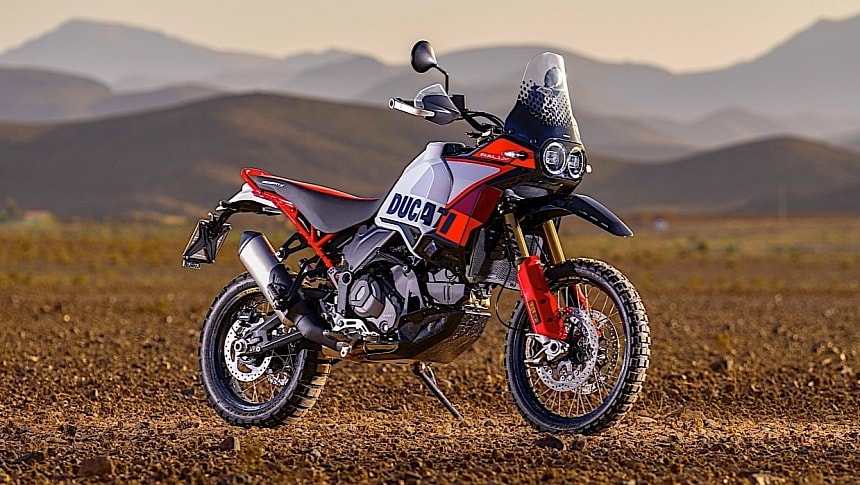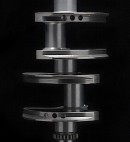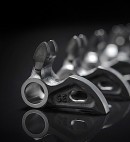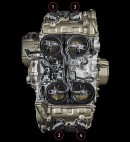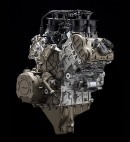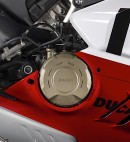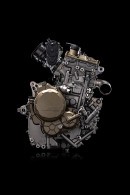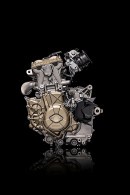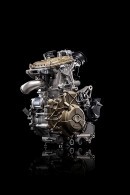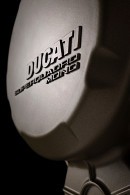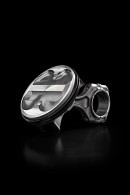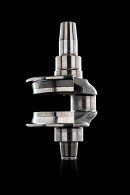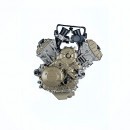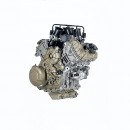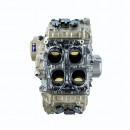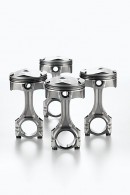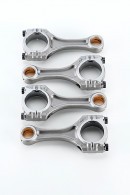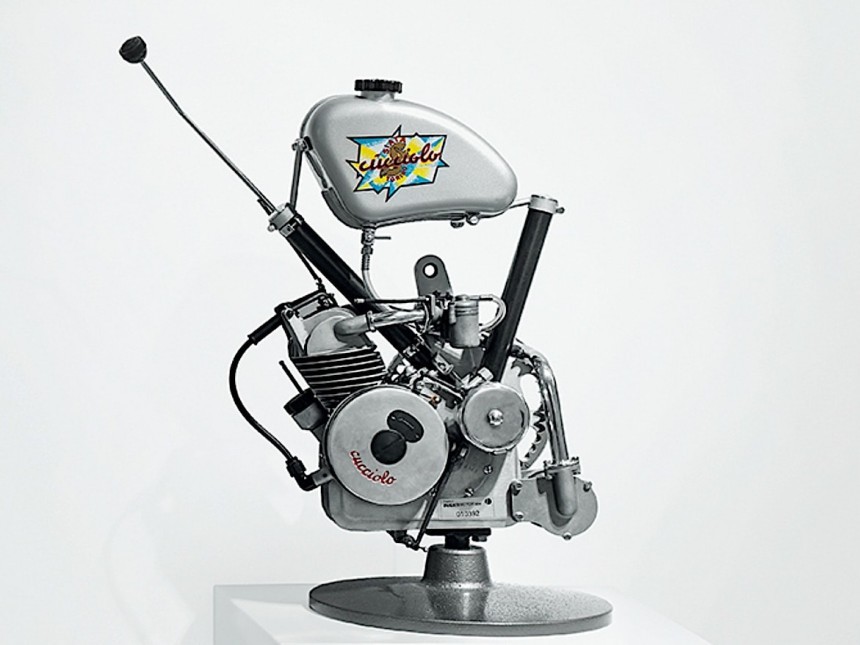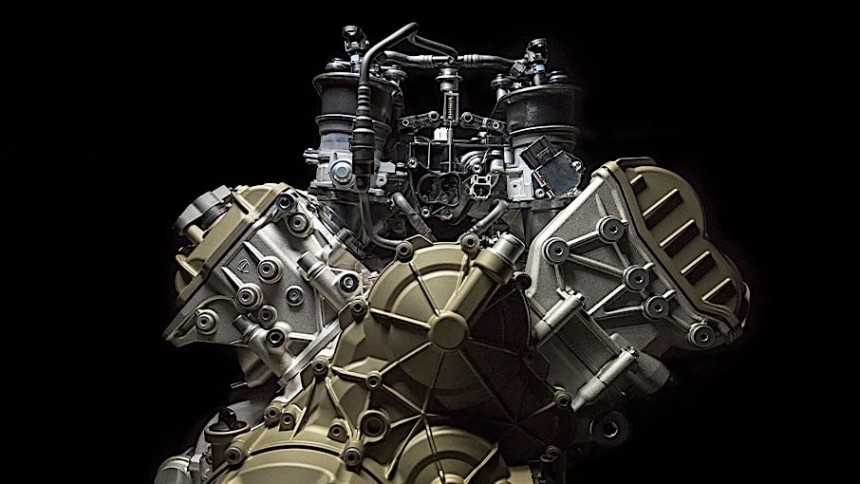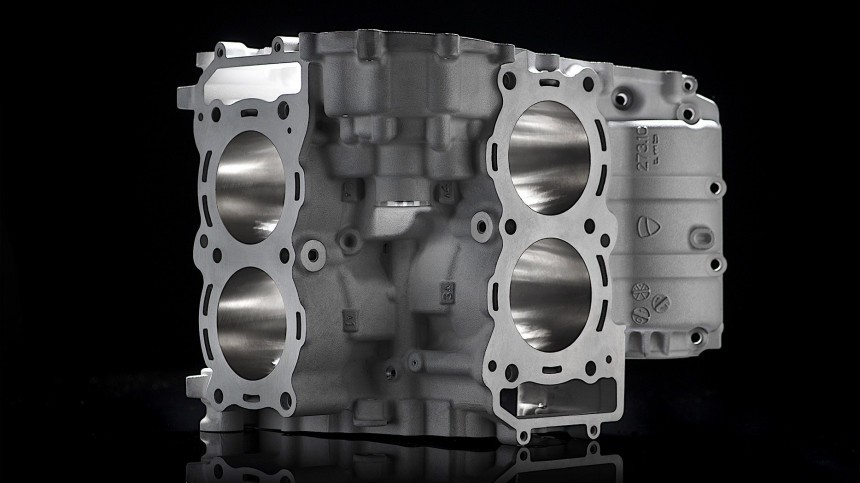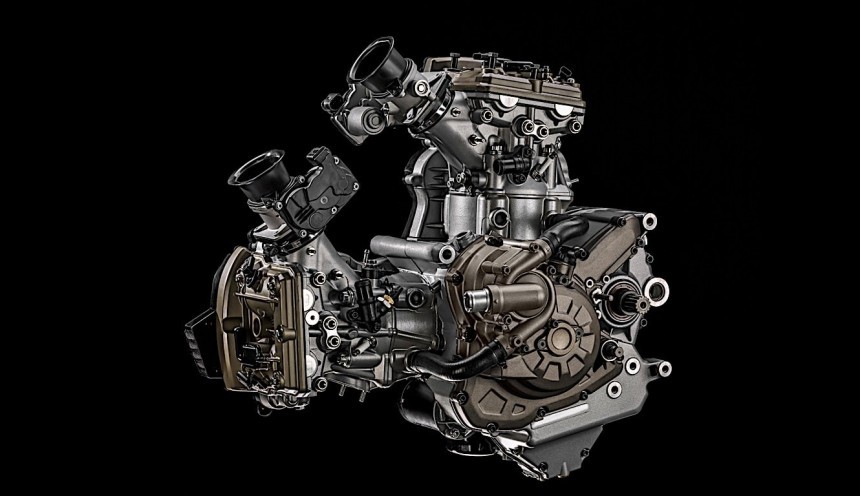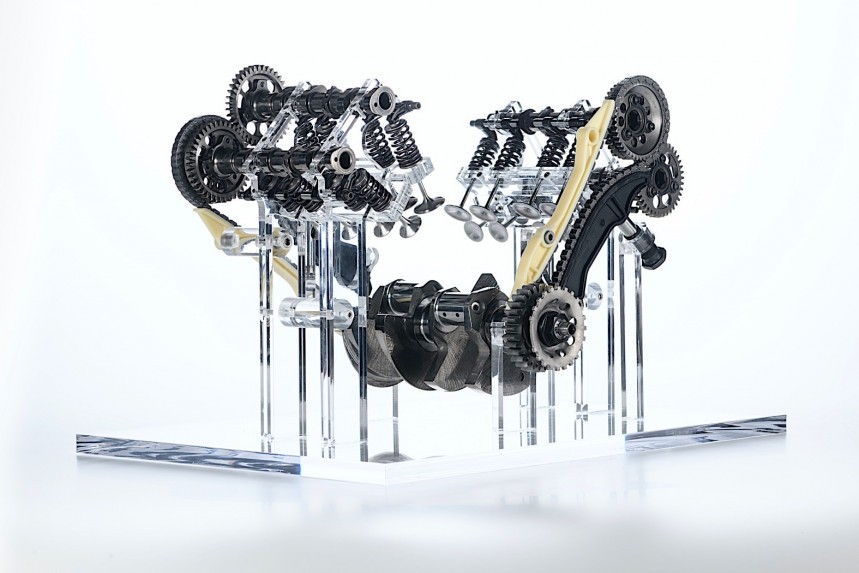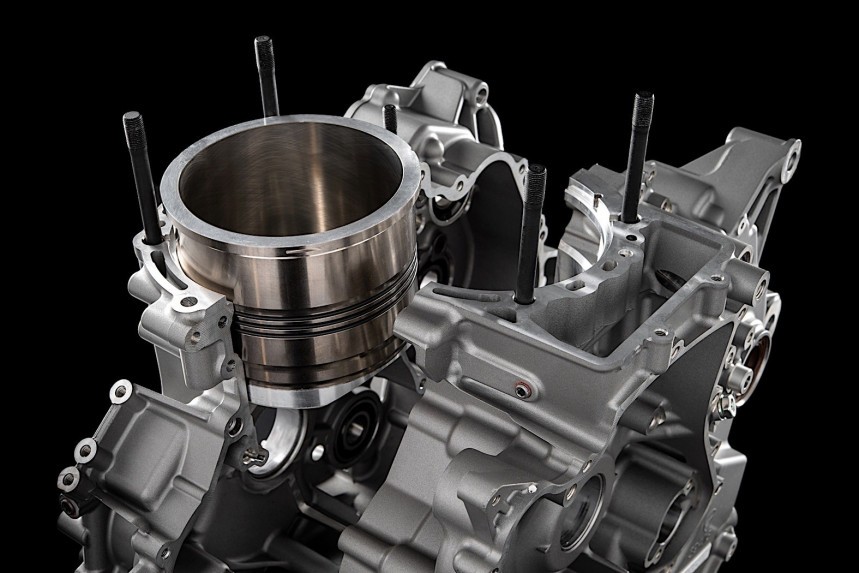Ducati is one of the biggest names in motorcycle making, its greatness coming not only from the products it sells to the general public but also from the many racing exploits it is involved in. And on top of it all, the two-wheelers wearing the Ducati logo are often likened by fans to the machines with double the number of wheels another Italian icon, Ferrari, is making. And that's a bit weird, considering how the company is owned by Ferrari's greatest rival, Lamborghini.
The company was born in 1928 in Bologna as Società Scientifica Radiobrevetti Ducati, and it was originally in the business of making radio components. Somehow, despite the many challenges it faced, including Allied bombs dropping on its factories during the Second World War, radio components kept rolling off the lines.
After Italy's liberation in 1944, Ducati tapped a company called Società Italiana per Applicazioni Tecniche Auto-Aviatori (SIATA) for a collab on pushrod engines that could be mounted on bicycles. Called Cucciolo, the engine proved successful enough to put Ducati on the map of motorcycle makers, and forever alter its destiny.
At the time of writing the Italians are an industry powerhouse, as they are selling no less than 46 distinct motorcycle models across 12 families. Each of these bikes have something unique to offer to riders, but it's not them per se we will be focusing on in this extensive coverage of ours.
We will instead take a look at the engines that powered Ducati motorcycles over the years, starting with that initial Cucciolo and ending with the recently introduced Superquadro Mono, Ducati's first single-cylinder powerplant in three decades.
Before getting into it, it's worth mentioning a thing or two about the Italians' nomenclature regarding their engines. You'll notice later on Ducati's powerplants are generally included in a few distinct families: Desmo, Testastretta, Granturismo, and Superquadro.
The first term, Desmo, is a reference to the way the valves inside the engine are controlled. Instead of being closed and opened by a spring, as it happens in most engines today, the poppet valve in these beauties is operated by means of a cam and leverage system – there are two of each for each valve. As far as we know, Ducati is the only maker of vehicles to use the system today.
Testastretta is the Italian term for narrow head. When used in relation to motorcycles it translates into the engines used on bikes from a certain generation onward, which come with different dimensions than before of the cylinder head.
The term Granturismo might be a bit confusing, as it is generally used to depict a car meant to be driven in style for long stretches of road and for a long time. Ducati, however, uses it to describe the powerplants that animate the bikes meant for something it calls "adventouring."
Last but not least, the Superquadro newcomer, which literally translates into "super square," is a single-cylinder powerplant with an extreme ratio between bore and stroke.
So let's dive into it, then, and see what Ducati had to offer on the engine front over the years.
As said, Ducati's adventure in the motorcycle industry started in 1946 with the Cucciolo engine developed by SIATA. It was a clip-on engine that could be installed on bicycles to give them a motorized push, named so (the term translates to cub) because the sound it made resembled that of a pup's yapping.
The unit was a four-stroke contraption that at its finest displaced 48cc (almost 3ci) and needed just 1.5 liters of fuel to travel 100 km (180 mpg). It was potent enough to push bicycles to speeds of up to 40 mph (64 kph).
The Cucciolo engine went on to power bicycles that became known as the Ducati Cucciolo, especially when used on a home-brewed moped that utilized a three-speed gearbox and lacked bicycle pedals – that happened in 1952 on a two-wheeler that became known as the Model 48.
The Cucciolo engine was immensely successful, selling hundreds of thousands of examples until it was discontinued in its initial form to make room for Ducati's first proper motorcycles starting in 1952. They were, technically, evolutions of the pup engine, only with larger displacements, meaning 55 or 65cc.
Ducati's adventure in the motorcycle world didn't really start until 1956. It was then that Italian engineer Fabio Taglioni came up with an engine design the company had never seen before, the mighty Desmo 125.
The powerplant was the first Ducati piece of technology to feature desmodromic timing, and it was installed in the company's first race motorcycle to have no fairing up front. The single-cylinder engine's specs sheet points to it having a displacement of 124,6cc, from which just 19 horsepower at 13,000 rpm could escape.
The desmodromic moved from the race track and onto the road in the late 1960s, but the Italians generally stuck with the single-cylinder design. It wasn't until 1972 that a two-cylinder was to join the range.
The L-shaped engine was aptly called Desmodue, and it was first deployed on the 750 GT. It had a displacement of 748cc and a power output of 60 horsepower at 8,000 rpm. That made it capable of pushing the two-wheeler to a top speed of 200 kph (124 mph).
The bike became the basis for "one of the most beautiful and highly appreciated motorcycles of the 1970s," as Ducati calls the 750 SS Desmo. And others seem to have thought so as well, as the motorcycle was on display at the Guggenheim Museum in New York.
The Desmodue was followed in the Desmodromic family's timeline by the Desmoquattro, which entered production for the first time in 1985. As the name says, we're dealing with a twin-cylinder unit with four valves.
Unlike the Desmo 125 and the Desmodue, the Desmoquattro was produced since its inception in the mid-1980s in several versions, with displacements ranging from 748 to 1,198cc. This range of powerplants was deployed on a large number of high-profile Ducati motorcycles, especially superbikes, starting with the 748 and burning through the 851, the 888, and the 916.
Sometime in the mid-2000s, and for a brief period of just three years, the Italians offered in their engine range something called the Desmotre. As its name says, it was a unit with a three-valve desmo head, and it was capable of running with the power of 102 hp and 93 Nm of torque. The powerplant was only used on a single motorcycle, the ST3 (and its ST3s variant), which was in production from 2004 to 2007. For reasons that were never properly explained, both the bike and the engine were abruptly discontinued.
The pinnacle of the Ducati Desmo family of engines is, naturally, the Desmosedici, the unit that presently powers all of the bike maker's supersport bikes. In its present form, the Italians refer to it as the Desmosedici Stradale.
A throwback to the engine Ducati has been using on MotoGP motorcycles, the engine is a 90-degree V4, only rotated back 42 degrees. As per its maker that makes the engine extremely compact and allows the masses to be better centered.
Another element the engine borrows from MotoGP machines is the counter-rotating crankshaft, allowing the bikes that use it to be particularly precise during cornering, among other things.
The displacement of the Desmosedici Stradale is 1,103cc, but there is also an R version, fitted on the Panigale V4 R, that comes in at 998cc. This variant cranks out a heart-stopping troop of 218 horsepower in the stock version and 327 hp when running the racing exhaust. The same unit is also deployed on the Superleggera V4.
The Testastretta breed is at its core desmodromic as well, and more precisely, a derivation of the Desmoquattro. However, these engines use narrower cylinder heads, which resulted from increasing the bore and shortening the stroke and translates into improved airflow, more complete combustion, and ultimately more peak power.
The first Testastretta engine, a 998cc version, was deployed on the 996R in 2001, and it came with 135 horsepower and 105 Nm of torque. It was later also fitted on the 998 and 999, with power increasingly slightly in the latter application.
In 2007, the same year the Italians released the Desmotre, they also let loose a powerplant called Testastretta Evoluzione. An improvement of the previous design, it was a liquid-cooled L-twin that was lighter than before
The engine was made in three displacements (1,099cc, 1,198cc, and 849cc), and it was used on several Ducati bikes of the age, including the 1098, its variants, and the 848 superbike.
The present-day lineup of Ducati motorcycles equipped with a Testastretta engine use a version called 11-degree. The moniker is there to represent the amount of valve overlap in the twin-cylinder, liquid-cooled, desmodromic timing powerplant. Generally speaking, the hardware is capable of delivering a total of 111 horsepower.
The Italians rolled out this variant of the engine first on the Monster and later on the Multistrada, complete with an eight-plate clutch. It now powers bikes from the two families, but also the DesertX, Supersport 950, and Hypermotard 950. In all applications the displacement of the engine is 937cc. On some of these bikes the engine is known as the Testastretta DVT because of a variable timing system that acts on both the intake and exhaust valves.
Back in 2020 Ducati let loose into this world the Multistrada V4, the world's first production motorcycle to be fitted with front and rear radars. Impressive as that feature might have been, it didn't even come close to the thing's engine.
The brand-new powerplant, aptly called V4 Granturismo, stole the crown of the lightest Ducati engine from the Testastretta twin-cylinder, tipping the scales at just 66.7 kg (147 pounds). Large enough to be noticed (1,158cc in displacement), the hardware came with a new spring valve return system, part chain/part gear–timing distribution, and a counter-rotating crankshaft.
In this configuration, the V4 Granturismo was capable of delivering 170 hp at 10,500 rpm and a maximum torque of 125 Nm at 8,750 rpm. Its use was further expanded to include more versions of the Multistrada, namely the V4 S Grand Tour, V4 Rally, and V4 Pikes Peak. Most importantly, though, it is also the beating heart of the Diavel V4 and the Diavel for Bentley special edition motorcycle.
Going back about a decade before the arrival of the V4 Granturismo, we stumble upon an engine breed that came to be known as the Superquadro. The unit arrived in 2011 as a V-twin four-stroke that uses the bike maker's favored desmodromic system.
The powerplant was first unleashed as the heart of the 1199 Panigale, and displaced back then 1,198cc. As time went on, the range diversified so it ended up covering a wider displacement range, from 898 to 1,285cc.
The Superquadro family got a major boost at the end of 2023, when something called the Superquadro Mono came under the spotlight. Unlike the previous units in this range, this one is a single-cylinder, the first one produced by the Italians over the past three decades (the one produced back then was the Supermono 550).
Just like all other Superquadro engines, the Mono has an extreme bore and stroke ratio of 1.86. That number is, according to Ducati, the "most extreme value ever seen on a road single-cylinder engine."
Based on the powerplant deployed on the Panigale 1299, the Mono is 659cc in displacement, but its rather small size doesn't make it less impressive as far as power levels are concerned. A total of 77.5 horsepower at 9,750 rpm is generated by the short-stroke single-cylinder, making it (again, as per Ducati) the most powerful single-cylinder engine in the world.
As if that's not enough, the value can be taken even higher, to 84.5 hp at 9,500 rpm, when fitted with a specially designed Termignoni exhaust system.
Soon after the engine was presented Ducati pulled the wraps off the first motorcycle to use it. We know the bike as the Hypermotard 698 Mono, and it will probably be followed in the coming months and years by more models.
After Italy's liberation in 1944, Ducati tapped a company called Società Italiana per Applicazioni Tecniche Auto-Aviatori (SIATA) for a collab on pushrod engines that could be mounted on bicycles. Called Cucciolo, the engine proved successful enough to put Ducati on the map of motorcycle makers, and forever alter its destiny.
At the time of writing the Italians are an industry powerhouse, as they are selling no less than 46 distinct motorcycle models across 12 families. Each of these bikes have something unique to offer to riders, but it's not them per se we will be focusing on in this extensive coverage of ours.
We will instead take a look at the engines that powered Ducati motorcycles over the years, starting with that initial Cucciolo and ending with the recently introduced Superquadro Mono, Ducati's first single-cylinder powerplant in three decades.
Before getting into it, it's worth mentioning a thing or two about the Italians' nomenclature regarding their engines. You'll notice later on Ducati's powerplants are generally included in a few distinct families: Desmo, Testastretta, Granturismo, and Superquadro.
The first term, Desmo, is a reference to the way the valves inside the engine are controlled. Instead of being closed and opened by a spring, as it happens in most engines today, the poppet valve in these beauties is operated by means of a cam and leverage system – there are two of each for each valve. As far as we know, Ducati is the only maker of vehicles to use the system today.
Testastretta is the Italian term for narrow head. When used in relation to motorcycles it translates into the engines used on bikes from a certain generation onward, which come with different dimensions than before of the cylinder head.
The term Granturismo might be a bit confusing, as it is generally used to depict a car meant to be driven in style for long stretches of road and for a long time. Ducati, however, uses it to describe the powerplants that animate the bikes meant for something it calls "adventouring."
Last but not least, the Superquadro newcomer, which literally translates into "super square," is a single-cylinder powerplant with an extreme ratio between bore and stroke.
So let's dive into it, then, and see what Ducati had to offer on the engine front over the years.
Cucciolo
The unit was a four-stroke contraption that at its finest displaced 48cc (almost 3ci) and needed just 1.5 liters of fuel to travel 100 km (180 mpg). It was potent enough to push bicycles to speeds of up to 40 mph (64 kph).
The Cucciolo engine went on to power bicycles that became known as the Ducati Cucciolo, especially when used on a home-brewed moped that utilized a three-speed gearbox and lacked bicycle pedals – that happened in 1952 on a two-wheeler that became known as the Model 48.
The Cucciolo engine was immensely successful, selling hundreds of thousands of examples until it was discontinued in its initial form to make room for Ducati's first proper motorcycles starting in 1952. They were, technically, evolutions of the pup engine, only with larger displacements, meaning 55 or 65cc.
The Desmo family
The powerplant was the first Ducati piece of technology to feature desmodromic timing, and it was installed in the company's first race motorcycle to have no fairing up front. The single-cylinder engine's specs sheet points to it having a displacement of 124,6cc, from which just 19 horsepower at 13,000 rpm could escape.
The desmodromic moved from the race track and onto the road in the late 1960s, but the Italians generally stuck with the single-cylinder design. It wasn't until 1972 that a two-cylinder was to join the range.
The L-shaped engine was aptly called Desmodue, and it was first deployed on the 750 GT. It had a displacement of 748cc and a power output of 60 horsepower at 8,000 rpm. That made it capable of pushing the two-wheeler to a top speed of 200 kph (124 mph).
The bike became the basis for "one of the most beautiful and highly appreciated motorcycles of the 1970s," as Ducati calls the 750 SS Desmo. And others seem to have thought so as well, as the motorcycle was on display at the Guggenheim Museum in New York.
The Desmodue was followed in the Desmodromic family's timeline by the Desmoquattro, which entered production for the first time in 1985. As the name says, we're dealing with a twin-cylinder unit with four valves.
Sometime in the mid-2000s, and for a brief period of just three years, the Italians offered in their engine range something called the Desmotre. As its name says, it was a unit with a three-valve desmo head, and it was capable of running with the power of 102 hp and 93 Nm of torque. The powerplant was only used on a single motorcycle, the ST3 (and its ST3s variant), which was in production from 2004 to 2007. For reasons that were never properly explained, both the bike and the engine were abruptly discontinued.
The pinnacle of the Ducati Desmo family of engines is, naturally, the Desmosedici, the unit that presently powers all of the bike maker's supersport bikes. In its present form, the Italians refer to it as the Desmosedici Stradale.
A throwback to the engine Ducati has been using on MotoGP motorcycles, the engine is a 90-degree V4, only rotated back 42 degrees. As per its maker that makes the engine extremely compact and allows the masses to be better centered.
Another element the engine borrows from MotoGP machines is the counter-rotating crankshaft, allowing the bikes that use it to be particularly precise during cornering, among other things.
The displacement of the Desmosedici Stradale is 1,103cc, but there is also an R version, fitted on the Panigale V4 R, that comes in at 998cc. This variant cranks out a heart-stopping troop of 218 horsepower in the stock version and 327 hp when running the racing exhaust. The same unit is also deployed on the Superleggera V4.
The Testastretta family
The first Testastretta engine, a 998cc version, was deployed on the 996R in 2001, and it came with 135 horsepower and 105 Nm of torque. It was later also fitted on the 998 and 999, with power increasingly slightly in the latter application.
In 2007, the same year the Italians released the Desmotre, they also let loose a powerplant called Testastretta Evoluzione. An improvement of the previous design, it was a liquid-cooled L-twin that was lighter than before
The engine was made in three displacements (1,099cc, 1,198cc, and 849cc), and it was used on several Ducati bikes of the age, including the 1098, its variants, and the 848 superbike.
The present-day lineup of Ducati motorcycles equipped with a Testastretta engine use a version called 11-degree. The moniker is there to represent the amount of valve overlap in the twin-cylinder, liquid-cooled, desmodromic timing powerplant. Generally speaking, the hardware is capable of delivering a total of 111 horsepower.
The Italians rolled out this variant of the engine first on the Monster and later on the Multistrada, complete with an eight-plate clutch. It now powers bikes from the two families, but also the DesertX, Supersport 950, and Hypermotard 950. In all applications the displacement of the engine is 937cc. On some of these bikes the engine is known as the Testastretta DVT because of a variable timing system that acts on both the intake and exhaust valves.
The V4 Granturismo
The brand-new powerplant, aptly called V4 Granturismo, stole the crown of the lightest Ducati engine from the Testastretta twin-cylinder, tipping the scales at just 66.7 kg (147 pounds). Large enough to be noticed (1,158cc in displacement), the hardware came with a new spring valve return system, part chain/part gear–timing distribution, and a counter-rotating crankshaft.
In this configuration, the V4 Granturismo was capable of delivering 170 hp at 10,500 rpm and a maximum torque of 125 Nm at 8,750 rpm. Its use was further expanded to include more versions of the Multistrada, namely the V4 S Grand Tour, V4 Rally, and V4 Pikes Peak. Most importantly, though, it is also the beating heart of the Diavel V4 and the Diavel for Bentley special edition motorcycle.
The Superquadro family
The powerplant was first unleashed as the heart of the 1199 Panigale, and displaced back then 1,198cc. As time went on, the range diversified so it ended up covering a wider displacement range, from 898 to 1,285cc.
The Superquadro family got a major boost at the end of 2023, when something called the Superquadro Mono came under the spotlight. Unlike the previous units in this range, this one is a single-cylinder, the first one produced by the Italians over the past three decades (the one produced back then was the Supermono 550).
Just like all other Superquadro engines, the Mono has an extreme bore and stroke ratio of 1.86. That number is, according to Ducati, the "most extreme value ever seen on a road single-cylinder engine."
Based on the powerplant deployed on the Panigale 1299, the Mono is 659cc in displacement, but its rather small size doesn't make it less impressive as far as power levels are concerned. A total of 77.5 horsepower at 9,750 rpm is generated by the short-stroke single-cylinder, making it (again, as per Ducati) the most powerful single-cylinder engine in the world.
As if that's not enough, the value can be taken even higher, to 84.5 hp at 9,500 rpm, when fitted with a specially designed Termignoni exhaust system.
Soon after the engine was presented Ducati pulled the wraps off the first motorcycle to use it. We know the bike as the Hypermotard 698 Mono, and it will probably be followed in the coming months and years by more models.
